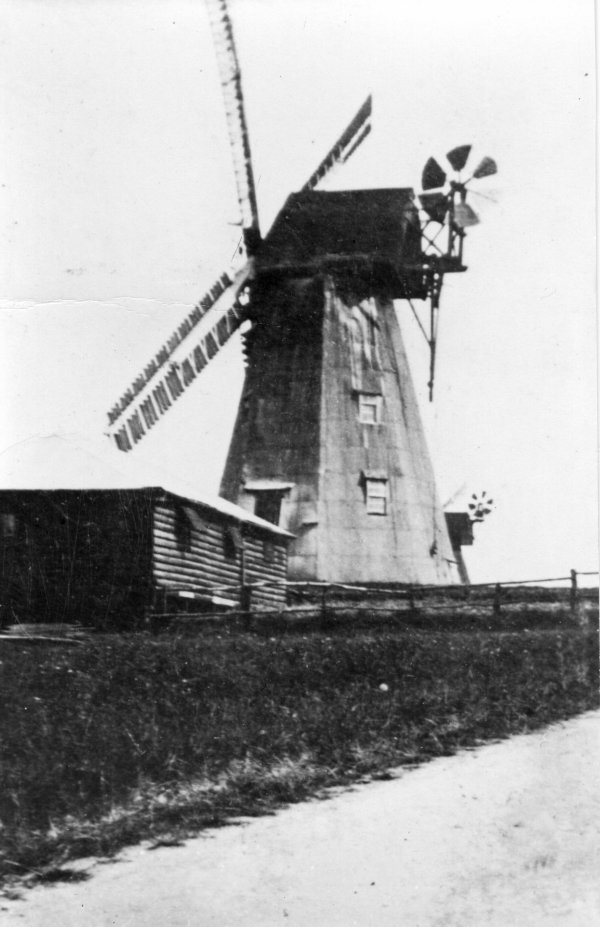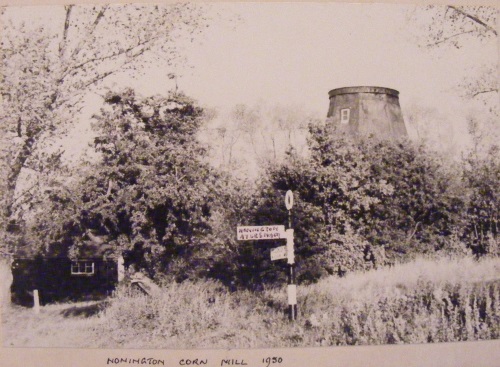Windmill in Stained Glass, King’s College, Cambridge, 16th Century
Written records show that there has been a windmill at the top of Mill Lane in Nonington from at least the end of the 15th century, the 1501 Essesole Manor Rolls have a reference to a “Milbarogh” (mill barrow) in this area. It is not certain whether the “Milbarogh” was a re-used ancient burial mound or a mound specifically built for the mill to stand on.
In his will of 1548 William Boys of nearby Fredville allowed his mother to take half the profits of the wind mill, at this date a post mill, on or near the Mill Lane site. Some fifty years later Symonson’s map of Kent showed a windmill on or near the Mill Lane site,but no mills at the nearby Barfreston site.
In 1626 Sir Edward Boys of Fredville settled some of his large land holdings on John Boys, his grandson, on his marriage to Margaret Miller of Wrotham. The settlement included “all that piece of land there called the Millner Downe with a wind Mill thereupon late in the tenure or occupation of John Jourdan this assign containing by estimation nine and twenty acres and two roods more or less”.
Later maps of 1695 and 1736 show a mill at the top of Mill Lane, but this had disappeared by 1769, possibly because had been superseded the two Barfreston mills which seem to have started working circa 1765. In his 1933 book on Kent mills William Coles Finch wrote that he believed the old Easole post mill disappeared just after 1769. A new wooden clad brick based smock mill, which had three sets of stones, three floors and was 24 feet in diameter, appears to have replaced the old mill in the 1780′s.
Circa 1890 the corn mill was re-clad with heavy duty iron sheeting which was much cheaper and more durable than the original timber boarding. By this time costs had to be kept low as this type of mill had become less profitable because most commercial flour milling was by then done by large steam powered mills which ground a much finer, purer flour and the smaller old fashioned mills mainly survived by processing local crops into animal feeds.










The mill sweeps became unsafe after a severe storm in 1905 and were consequently removed and in common with many other mills at the time an oil engine was installed. In the autumn of 1911 the mill was taken on by Edward ‘Teddy’ Gasston, the last miller at the Easole Mill, who ceased milling there in April, 1953 but he continued to live in the mill workers cottage with his sister until his death. (see page 2 for Site of mill at Nonnington by A.W.May) The mill and associated buildings gradually fell into disrepair until in the early hours of Sunday 9th May of 1965, the mill, the two mill workers cottages and a large barn were severely damaged by fire and subsequently demolished (see page 2 for newspaper reports). The miller’s house survived and now much modified still stands on side of the St. Alban’s Downs road.
The mill was always referred to locally as “Gasston’s Mill”, a habit which continued long after the mill had gone.
Easole Corn Mill Millers.
1626 John Jourdan.
History of mill unknown until
1784 Richard Downing.
1785 Stephen Pain.
1803 Stephen Pain Jnr.
1813 John Oakley.
1819 Thos. Ashenden.
1819 Robert Matson.
1821 William Spanton.
1833 George Knight.
1837 George Clark
1842 Thomas Clark.
1859 Edgar Steed .
1861 James Dilnot, died in the spring of 1911.
1911-1953 Edward Gasston took over the mill in autumn of 1911 and stopped milling in April, 1953 but he continued to live in the mill workers cottage with his sister until his death.
1965 In the early hours of Sunday, 9th May, 1965. Easole M Corn ill was destroyed by fire. Reported in The Dover Express & East Kent News on Friday, 14th May, 1965.
Please click here to see the full newspaper article.
Also read: Teddy Gaston-Memories of a kind old miller, published in The Dover Express, 4th November, 1970.



Thank you for your comments on the item. I don’t hold copyright on any of the photos, they are all in the public domain as far as I am aware.
I am very interested to find this page, I have traced my family line back to my 7 times great grandfather Vincent Pain, the father of Stephen Pain that you list as Miller at the Easole Corn Mill in what I presume to be 1785 (could be a typo on the web page?) – my great great uncle Franklin Pain is mentioned, as a contributor and friend in the 1933 William Coles Finch book you quote, I have a copy.
I volunteer at a local Derbyshire windmill and am preparing articles for our quarterly magazine and will quote your website therein, if I may – do you hold the copyright on the above photos of the mill ? – I have a collection of photos passed down via my late grandfather from Franklin who was a miller and millwright, but am not sure I have one of Easole MIll.
Regards Andy
Hello, Teddy. I’ve sent copies of all the newspaper cuttings I have regarding the Easole Mill to your email address. I hope they come through without any problems.
Hi, I’m Teddy’s great grandson from my father’s side and am in fact named after him! I would love a copy of the 1970 Dover Express article as it won’t download for some reason.
Malcolm, I would be grateful for copies of both articles in PDF format to use on the website. Regards,
Hello Clive, just to let you know that I have a full readable copy of the above EKM article if you would like it (PDF format, but it could be scanned to any thing apropriate). Also, the article from the Dover Express in May 1965 describing the fire. Please let me know. Kind regards.